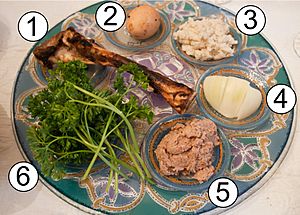Karpas facts for kids

1. Zeroa (shankbone)
2. Beitza (roasted hard-boiled egg)
3. Maror/Chazeret (horseradish)
4. Maror/Chazeret (onion)
5. Charoset
6. Karpas (parsley)
Karpas (Hebrew: כַּרְפַּס) is a special part of the Passover Seder. The Seder is a traditional meal and ceremony that Jewish families have during the holiday of Passover. Karpas is usually a green vegetable, like parsley or celery. Sometimes, people use raw onion or boiled potato instead.
During the Seder, you dip the karpas into a liquid. This liquid is often salt water or wine vinegar. The salt water is a symbol of the tears that the Jewish people cried when they were slaves in Egypt.
What is Karpas?
Karpas is one of the foods placed on the Seder plate. The Seder plate holds different symbolic foods for the Passover meal. Karpas is usually on the left side, below a roasted egg.
The word "Karpas" might come from the Greek word karpos. This word means a fresh, raw vegetable. It could also be related to the Persian word "karafs," which means celery.
Why is Karpas Dipped?
Dipping the karpas into salt water is done for a special reason. It helps to make children curious and ask questions. The Seder night is all about telling the story of Passover through questions and answers.
Dipping a vegetable before the main meal is not something people usually do. This unusual action makes kids wonder, "Why are we doing this?" Their questions help the story of Passover be told.
There is a second dipping later in the Seder. This is when maror (bitter herbs) is dipped into charoset (a sweet mixture). Because of these two dippings, one of the Four Questions asked during the Seder is: "On all other nights we do not dip vegetables even once; on this night, we dip twice."
Deeper Meanings of Karpas
Some people believe the dipping of Karpas into salt water has another meaning. It can remind us of the story of Joseph. His brothers dipped his special coat into blood. This event started the journey that led the Israelites to Egypt.
The Greek word 'karpos' is similar to an old Hebrew word 'karpas'. This Hebrew word means fine linen. Some also say the second dipping, later in the Seder, reminds us of hyssop being dipped in lamb's blood. This blood was painted on doorposts so the angel of death would 'pass over' those homes.
See also
 In Spanish: Karpás para niños
In Spanish: Karpás para niños


